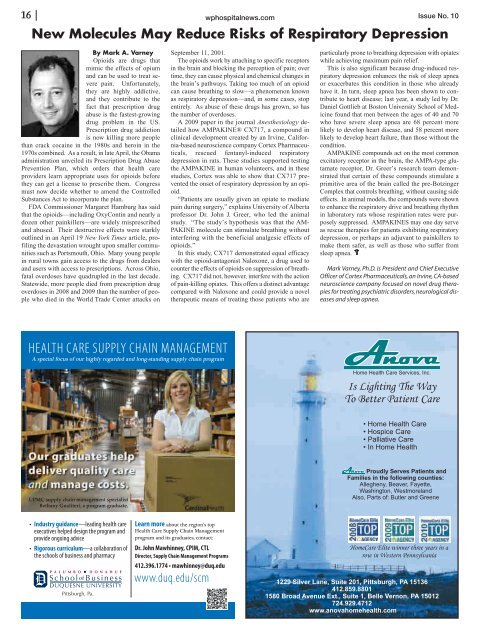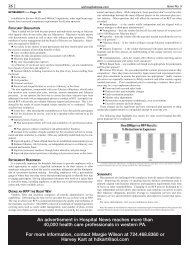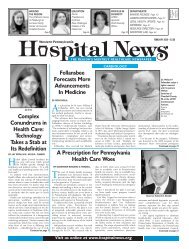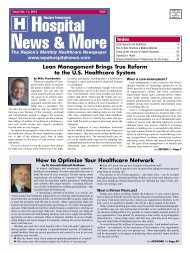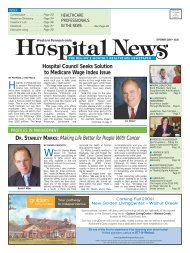Hospital News, 10-1-2011 - Western Pennsylvania Healthcare News
Hospital News, 10-1-2011 - Western Pennsylvania Healthcare News
Hospital News, 10-1-2011 - Western Pennsylvania Healthcare News
Create successful ePaper yourself
Turn your PDF publications into a flip-book with our unique Google optimized e-Paper software.
16 | wphospitalnews.comIssue No. <strong>10</strong>New Molecules May Reduce Risks of Respiratory DepressionBy Mark A. VarneyOpioids are drugs thatmimic the effects of opiumand can be used to treat severepain. Unfortunately,they are highly addictive,and they contribute to thefact that prescription drugabuse is the fastest-growingdrug problem in the US.Prescription drug addictionis now killing more peoplethan crack cocaine in the 1980s and heroin in the1970s combined. As a result, in late April, the Obamaadministration unveiled its Prescription Drug AbusePrevention Plan, which orders that health careproviders learn appropriate uses for opioids beforethey can get a license to prescribe them. Congressmust now decide whether to amend the ControlledSubstances Act to incorporate the plan.FDA Commissioner Margaret Hamburg has saidthat the opioids—including OxyContin and nearly adozen other painkillers—are widely misprescribedand abused. Their destructive effects were starklyoutlined in an April 19 New York Times article, profilingthe devastation wrought upon smaller communitiessuch as Portsmouth, Ohio. Many young peoplein rural towns gain access to the drugs from dealersand users with access to prescriptions. Across Ohio,fatal overdoses have quadrupled in the last decade.Statewide, more people died from prescription drugoverdoses in 2008 and 2009 than the number of peoplewho died in the World Trade Center attacks onSeptember 11, 2001.The opioids work by attaching to specific receptorsin the brain and blocking the perception of pain; overtime, they can cause physical and chemical changes inthe brain’s pathways. Taking too much of an opioidcan cause breathing to slow—a phenomenon knownas respiratory depression—and, in some cases, stopentirely. As abuse of these drugs has grown, so hasthe number of overdoses.A 2009 paper in the journal Anesthesiology detailedhow AMPAKINE® CX717, a compound inclinical development created by an Irvine, California-basedneuroscience company Cortex Pharmaceuticals,rescued fentanyl-induced respiratorydepression in rats. These studies supported testingthe AMPAKINE in human volunteers, and in thesestudies, Cortex was able to show that CX717 preventedthe onset of respiratory depression by an opioid.“Patients are usually given an opiate to mediatepain during surgery,” explains University of Albertaprofessor Dr. John J. Greer, who led the animalstudy. “The study’s hypothesis was that the AM-PAKINE molecule can stimulate breathing withoutinterfering with the beneficial analgesic effects ofopioids.”In this study, CX717 demonstrated equal efficacywith the opioid-antagonist Naloxone, a drug used tocounter the effects of opioids on suppression of breathing.CX717 did not, however, interfere with the actionof pain-killing opiates. This offers a distinct advantagecompared with Naloxone and could provide a noveltherapeutic means of treating those patients who areparticularly prone to breathing depression with opiateswhile achieving maximum pain relief.This is also significant because drug-induced respiratorydepression enhances the risk of sleep apneaor exacerbates this condition in those who alreadyhave it. In turn, sleep apnea has been shown to contributeto heart disease; last year, a study led by Dr.Daniel Gottlieb at Boston University School of Medicinefound that men between the ages of 40 and 70who have severe sleep apnea are 68 percent morelikely to develop heart disease, and 58 percent morelikely to develop heart failure, than those without thecondition.AMPAKINE compounds act on the most commonexcitatory receptor in the brain, the AMPA-type glutamatereceptor. Dr. Greer’s research team demonstratedthat certain of these compounds stimulate aprimitive area of the brain called the pre-BotzingerComplex that controls breathing, without causing sideeffects. In animal models, the compounds were shownto enhance the respiratory drive and breathing rhythmin laboratory rats whose respiration rates were purposelysuppressed. AMPAKINES may one day serveas rescue therapies for patients exhibiting respiratorydepression, or perhaps an adjuvant to painkillers tomake them safer, as well as those who suffer fromsleep apnea.Mark Varney, Ph.D. is President and Chief ExecutiveOfficer of Cortex Pharmaceuticals, an Irvine, CA-basedneuroscience company focused on novel drug therapiesfor treating psychiatric disorders, neurological diseasesand sleep apnea.HEALTH CARE SUPPLY CHAIN MANAGEMENTA special focus of our highly regarded and long-standing supply chain programHome Health Care Services, Inc.Is Lighting The WayTo Better Patient Care• Home Health Care• Hospice Care• Palliative Care• In Home HealthUPMC supply chain management specialistBethany Gualiteri, a program graduate.Proudly Serves Patients andFamilies in the following counties:Allegheny, Beaver, Fayette,Washington, WestmorelandAlso, Parts of: Butler and Greene Rigorous curriculum Pittsburgh, Pa.Learn more about the region’s topHealth Care Supply Chain Managementprogram and its graduates, contact:Dr. John Mawhinney, CPIM, CTLDirector, Supply Chain Management Programswww.duq.edu/scmHomeCare Elite winner three years in arow in <strong>Western</strong> <strong>Pennsylvania</strong>1229 Silver Lane, Suite 201, Pittsburgh, PA 15136412.859.88011580 Broad Avenue Ext., Suite 1, Belle Vernon, PA 15012724.929.4712www.anovahomehealth.com


